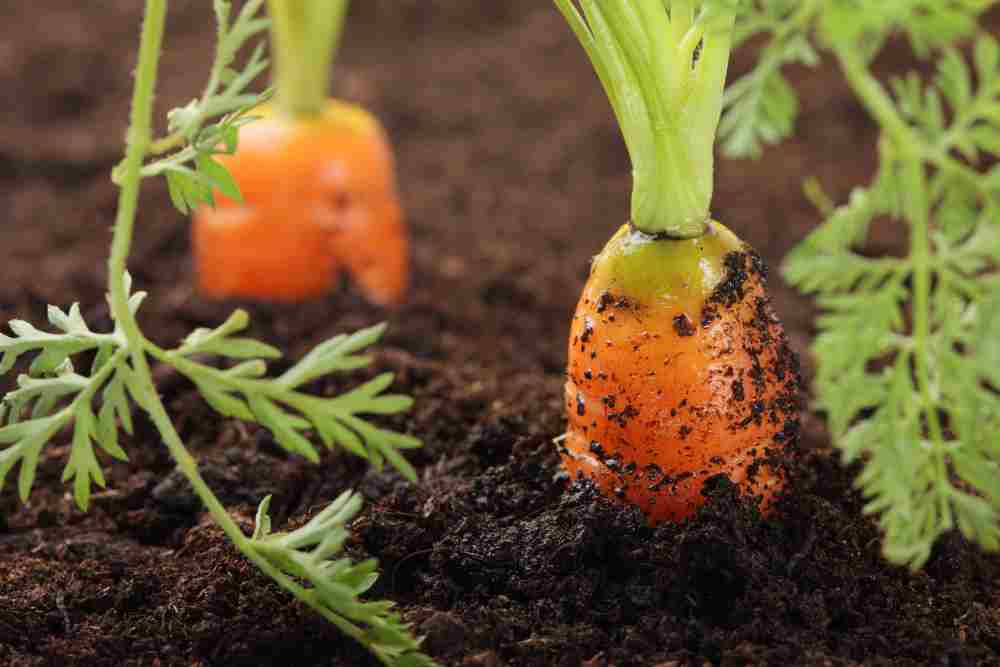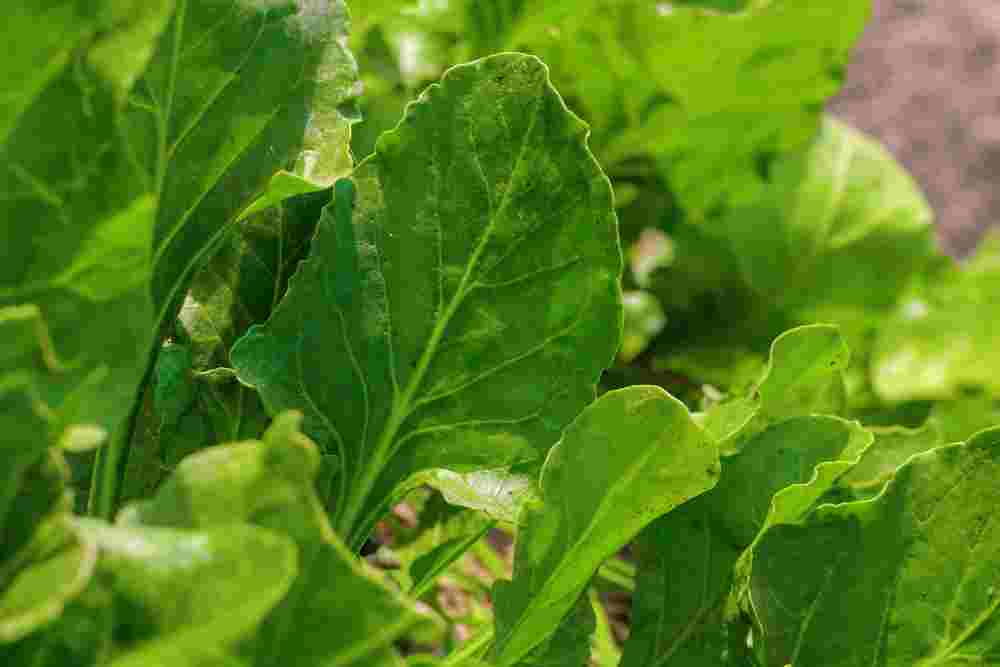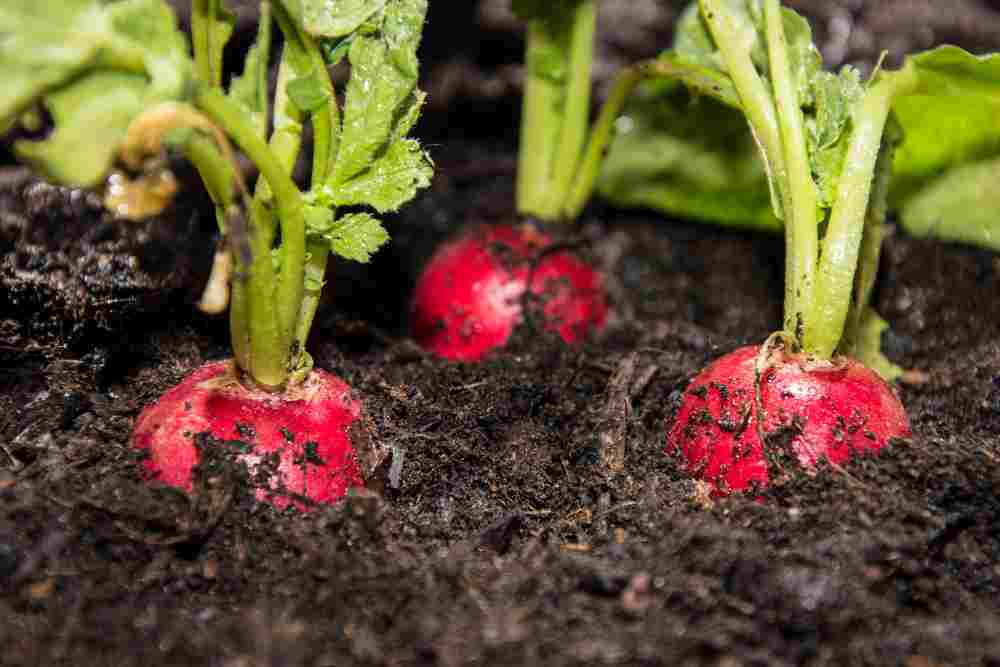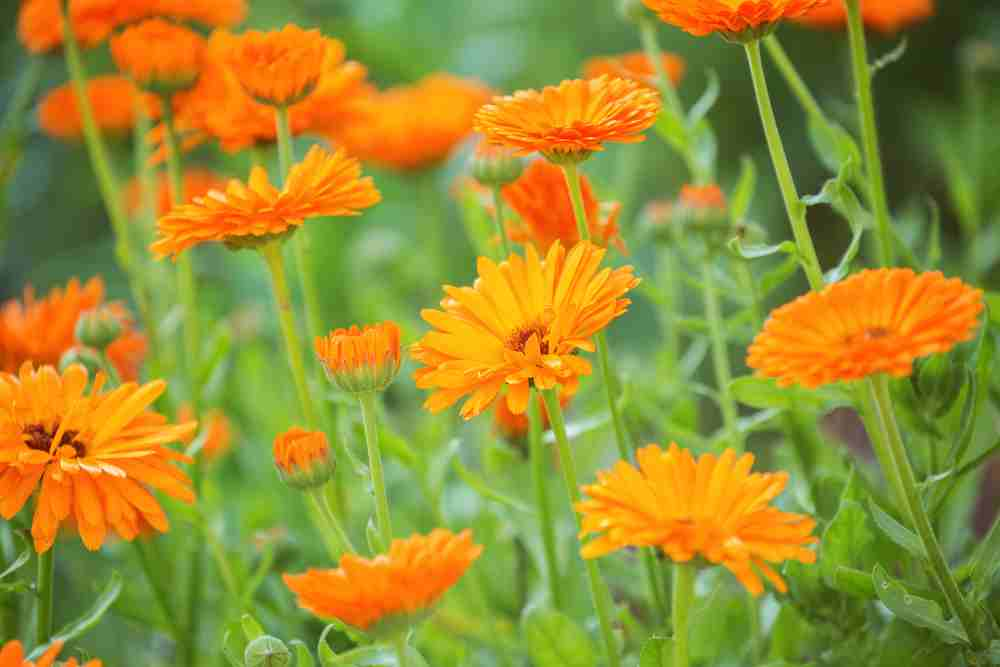What to Grow in a Raised Garden Bed for Bountiful Harvests
Raised garden beds are a creative approach to growing plants in structures above the ground’s surface. Raised bed gardening offers countless advantages. Raised soil can be managed in terms of quality, resulting in a warm, nutrient-rich, well-draining growing environment for optimal root development and plant growth.
Raised bed structures improve soil quality, increase growing area, reduce bending and weeding requirements, and even prevent pests. Raised beds can be made out of wood, metal, stone, or brick and arranged in various ways, but what to grow in a raised garden bed?
Here we give 30 things including vegetables, fruits, flowers, and green leaves to grow in your raised bed.
1. Carrots

Carrots do well in raised beds since they are simple to cultivate and plant. A raised bed’s loose, aerated soil provides plenty of room for root vegetables like carrots to develop. You can plant about 18 carrots on a square foot of ground; however, different cultivars have varied requirements.
Considering how little carrot seeds are, carrot seeds only need to be sowed about 1/4 inch deep. Water the carrots gently, careful not to wash away the tiny seeds. Depending on your space, you should plant twice as many seeds. To ensure that the carrots have enough area to develop, you should thin them as they mature. To ensure a continual crop, you can succession sow carrots all season long.
2. Cucumbers

Cucumbers have bush and vining forms. You can plant either one in a raised bed, but if it’s small and you want to produce vining cucumbers, you should use a trellis. Cucumbers trained to grow up a trellis are simple to identify and select since they grow straight up the trellis. The recommended spacing and depth for planting cucumber seeds are six inches apart and no deeper than one inch. If you plan to use a trellis, plant them close to it.
3. Onions

The ideal vegetable to produce in raised beds is onions, and there are three reasons why this is the case. They prefer quick-draining soil, require a lot of organic content, and need a long growing season. Raised bed soil is naturally adaptable, so if you know you’ll be planting onions in the bed, you can add a lot of compost.
The maturation period for onions produced from seeds might exceed 100 days. If you live somewhere with four seasons, give these babies as much time in the garden as possible. You may plant early and give your onions a head start using raised beds because the soil warms up much faster than the ground. Learn how to grow bunching onions at home with this comprehensive guide on harvesting, pests, and Diseases for this versatile flavorful vegetable.
4. Potatoes

Potatoes grow well in a row in a raised bed and are much simpler to harvest. These plants gain from hilling the soil around the developing shoots. You can contain your hills in a raised bed, and you can even build an expanding bed as your plants mature. Loamy, loose soil with good drainage, is ideal for potatoes.
They thrive in loose soil where they can readily spread out, as this will prevent them from decaying. You get the advantage of having total control over the soil in a raised bed. Raised beds are more likely to produce potato crops with higher yields and larger tubers.
5. Lettuce

Any raised bed is a fantastic place to add lettuce. Although it is a cool-weather crop, it develops swiftly-plant lettuce seeds near peppers, tomatoes, and other larger plants.
Before the maturity of the larger plants, the lettuce will be ready for harvest. You can also fit a few lettuce plants into corners or odd spaces. Your lettuce seeds should be dispersed in a tiny block or thin line. Gently cover the seeds with soil. To prevent the small seeds from being washed away, water them very sparingly. You can harvest from each plant after the lettuce becomes established so that you can thin it out as it grows.
Every two weeks or whenever there is a small opening in your raised bed, continue to plant seeds of four-season lettuce, and this will supply you with fresh greens all summer without taking up valuable raised bed areas.
6. Kale

Each plant of kale requires around a square foot of space. Additionally, it favors cool climates, so you should plant your kale where it will get some afternoon shade. For instance, if your raised bed has tomato plants, you may put the kale there so that the tomato plants will shade it from the afternoon sun.
When transplanting kale plants into the raised bed, space them approximately a foot apart. If you start them from seeds, you can scatter a few seeds in the middle of each square foot. The weaker seedlings that are developing more slowly can be cut off as the kale starts to grow.
7. Spinach

There are no issues with planting spinach close to your lettuce and radishes. But since it thrives in cooler climates, start growing spinach early. Once it has been picked, put something else there, like radishes, and then plant more spinach there in the late summer or early fall when the temperature starts to calm down again. Spinach will germinate in a week if the appropriate circumstances exist. It should be planted similarly to lettuce. You can make a small trench and scatter spinach seeds all along it. Then, water carefully after lightly covering it with soil.
You can harvest the young leaves for eating instead of thinning your spinach because spinach can be consumed at any stage. Harvest every other plant as much as possible to leave space for the others to flourish.
8. Peas

Do you recall the trellis we constructed for our cucumbers? Make another, and you’ll have the perfect spot to produce a patch of wonderful, brilliant green peas. Since peas may be trained to grow up most of the space they actually occupy in a garden, you’ll have plenty of space to grow the rest of your vegetables. Crops should be grown in the spring and again in the fall when the weather begins to cool.
Peas are another favorite veggies to produce in raised beds since they are sweet and delicious. Install netting support along one side of the bed to make the most important use of the available area.
Pea seeds should be sown indoors in long “root trainer” pots since mice frequently consume them before they grow outdoors. When you plant them once they are big enough to handle, you have less root disturbance with them (which peas hate). Plant seeds in March and begin harvesting at the end of June.
9. Beetroot

Beets mature quickly; they may be edible in as little as 60 days. Seeds should be sown two to three inches apart and no deeper than an inch because they require a small growing space.
To ensure that your beets can develop to the proper size, your raised bed should be at least 12 inches deep. Beets require regular watering but should not be planted in damp soil. Harvest them for a sweeter, tastier beet when they are still little.
10. Mint

Mint can quickly take over a garden or yard, making it an excellent plant for a raised bed. Once it is established, harvest it frequently in a spot that receives direct sunlight. Just make sure it doesn’t take over the entire raised bed!
Growing mint from seeds can be challenging. The ideal way to produce healthy mint is to borrow some from a nearby friend or neighbor with a comparable growth environment and soil characteristics. If possible, dig an area the size of a square foot while collecting lots of roots. Place it there and give it plenty of water. Once planted, it is remarkably resistant to drought and requires minimal upkeep.
11. Swiss Chard

Raised beds and container gardens are excellent places to grow Swiss chard, which is both colorful and nourishing. Swiss chard can be planted early in the spring while the temperature is still cool, and it can easily withstand both cold and heat. Your Swiss chard should be spaced 12 to 18 inches apart. Water it frequently. When the leaves are large enough, you can consume them. Younger leaves are softer and have a more robust flavor.
12. Summer Squash

Summer squashes are abundant producers and come in a variety of forms. Consider shrub varieties like patty pan, yellow squash, and bush zucchini if your garden area is limited. To ensure that each plant has adequate air circulation, allow a small amount of breathing space around it. Your plants will be more vulnerable to issues like downy mildew if the humidity in the air is high. The wonderful thing about these squashes is that they bear a lot of fruit quickly and heavily, providing you with a lot of nourishment in a small area.
13. Radishes

The fastest-growing veggies are radishes, which are perfect for raised beds since they develop so quickly. You can plant radish seeds next to larger plants. Unlike your larger plants, which take much longer to mature, the radishes will be ready to harvest in 35 to 60 days.
Radishes can be crammed into any small gaps or empty spaces you may have. Wherever you want your radishes to grow, create a little trench, then scatter the seeds there gently. They should be lightly covered with soil and carefully watered. Radish seeds can be readily wiped away, and there may need to be some thinning if your seeds are planted densely.
14. Melons

Melons Raised beds are ideal for large fruiting plants like melons. The optimal growth environment for juicy melons of all varieties is warm, pH-balanced soil that is rich in nutrients and offers appropriate drainage. To make the most of available space, these vining plants can be trained to climb trellises or other climbing structures or let spill over the sides of raised beds.
15. Strawberries

Where the soil is warm and the sunlight is abundant; strawberry plants produce exceptionally well. These ideal circumstances are provided by raised beds, enabling strawberry plants to avoid dangerous slugs that feed on sweet fruits.
16. Brassicas

In a raised bed setting, brassicas provide excellent first-round early crops. The controlled soil temperatures that raised beds offer are ideal for them because they tend to bolt in high temps, and it keeps the soil warmer, extending the growing season for both early-season and late-season crops. They can also be easily covered in raised beds, making harvesting simple in the fall and winter.
17. Peppers And Eggplant

For a good reason, eggplant and colorful peppers are popular choices when considering what to plant on a raised garden bed. They are heavy nutrient feeders and do well in the warm soil of raised beds. Raised beds make it simpler for gardeners to meet these abundant plants’ nutrient and watering needs.
18. Zucchini

Zucchini enjoys hot temperatures and direct sunlight. When the soil is warm enough, you can directly seed your zucchini plants into a raised bed or another container. Add a lot of aged compost to keep the soil aerated and loose.
Plant seeds three to four inches apart, about half an inch deep. You should probably thin the plants once they’re established to be at least six inches apart. To avoid blossom end rot, make sure your plants are watered evenly.
In a raised bed, bush kinds will take up less space than vining varieties, which can utilize vertical space when planted on a trellis. You can fit a few extra plants if you choose kinds that grow on vines. Also, if you’d like, let the vines overhang the raised beds’ edges. Zucchinis are best plucked when they are between three and eight inches long. Larger zucchinis lose flavor and texture, even though they are still edible.
19. Celery

Celery is perfect for a raised bed since they have a shallow root system. They can be raised from seeds, young plants, or even by replanting the core of a bunch of celery that you purchased from the shop.
Eight to ten weeks before your last date of frost, you can start the seeds for celery indoors because it loves lower temperatures. Before putting your seedlings in your raised bed, harden them off. The celery roots will begin to rot if the soil is too wet, so ensure it gets enough water and compost to flourish. You can continuously harvest from a plant once it has been established.
Consider side-dressing it with extra compost throughout the growing season to ensure it keeps growing healthily. Some celery types can be harvested in as short as 80 days.
20. Beans

For the best harvest, plant your bush beans around every two weeks throughout the summer. Raised beds are also a viable option for growing pole beans, but they must be supported by a trellis, pole, or wire. They will produce beans for a longer period. Beans should be planted six to seven inches apart, one inch deep, and in full light. Bush beans will need to be slightly pruned out to make a place for pole beans to grow up their trellis.
21. Sunflowers

Sunflowers are a fantastic choice for a corner garden bed. They may provide a lot of color and texture to your flower garden and attract pollinators to the area. You may even attempt starting them from seed if you’re feeling very adventurous!
Make sure to give the sunflowers plenty of space when planting them in a raised garden bed. Sunflowers can reach heights of up to six feet, so leave each one at least two feet away from the other plants in the bed. Remember that some kinds may require staking, so plan ahead of time. Sunflowers grow well when planted among other veggies and flowers, which is another advantage of planting them in your raised garden bed.
For instance, sunflowers and tomatoes or peppers, both of which do well in raised beds, are frequently grown together. Sunflowers are the perfect solution if you’re searching for a simple approach to enhance your garden’s beauty and attractiveness while offering some delectable treats to you or the local wildlife.!
22. Borage

You can add this fantastic annual to your raised beds as well. This flower is edible, just like the marigolds mentioned, and it blends in perfectly with fruits and vegetables.
Growing borage is as simple as it gets because it self-seeds. In addition to serving as a trap crop for tiny sap-sucking insects, it is fantastic for bees and birds. Additionally, the root system of this flower does an incredible job of aerating and breaking up the soil.
23. Marigolds

Marigolds stand out as a flower that should be planted in a raised garden. When decorated with these colorful and cheerful flowers, any outdoor area will seem beautiful and charming. They are simple to grow and manage and look stunning when in bloom.
Marigolds, for instance, can be cultivated in tier-style garden beds, providing them with adequate room to develop and blossom. For best results, ensure the bed has enough drainage and is positioned where it will receive at least six hours per day of direct sunlight.
Gardeners have grown marigolds for years due to their low maintenance requirements and ability to attract beneficial insects. They are a wonderful option for gardeners searching for variety because they are available in a wide range of kinds and colors. When planted collectively, this species produces an eye-catching display, adding beauty and texture to any landscape design.
24. Calendula

Calendula, which resembles marigolds in appearance, is well known for drawing pollinators, including bees, butterflies, and beetles. Additionally, this plant serves as a trap crop for pests like aphids.
Calendula is an excellent cover crop and living mulch because of its thick, fibrous roots, which shield the soil. Make sure to use its faded petals as your compost activators once they start to fade. Calendula has a great capacity to predict the weather; once the flowers begin to close, rain is expected.
25. Clover

Clover is a nitrogen-fixing plant that gardeners can use as green manure to keep their raised beds fertile. Additionally, it is a strong companion crop that gets along well with various common annuals. It not only fixes nitrogen but also lessens moisture loss and the number of troublesome weeds.
Despite having a more straightforward appearance than some of the other flowers on our list, clover blooms are nonetheless quite fragrant and have a gorgeous appearance. Bees and other helpful animals are drawn to them as well.
26. Lavender

Lavender is an excellent companion plant for raised-bed vegetables since it prefers sunny, well-drained soil. It thrives particularly well in the vicinity of Mediterranean herbs like asparagus. It produces a wonderful edging; therefore, we suggest planting it on a mound around a raised bed of vegetables.
This flower attracts many good insects, including pollinators, and has a lovely scent. And, as you surely already know, lavender also has a wide range of culinary and other domestic uses.
27. Cosmos

Some flowers fit rather well in raised beds that are already filled with vegetables, despite being mostly grown for cutting. And of all of these, Cosmos is perhaps the finest option for people who are just starting out in the realm of square-foot gardening.
This particular plant has a long growth cycle and requires little maintenance. It’s a flower that’s helpful for wildlife because it draws “good” insects, including predators that eat sap-sucking bugs.
28. Petunias

The most popular flower to grow on metal garden beds is the petunia. They have a wide range of types and are simple to care for. The gorgeous petunias flowers have broad, ruffled petals and bloom in the spring and summer. Moreover, they are available in various colors, including pink, purple, white, and yellow.
Petunias should be planted in well-drained soil with lots of sunlight for the best results. Water them consistently during the growing season, usually once or twice a week. For optimal results, fertilize with a balanced fertilizer every four to six weeks.
29. Nasturtiums

Nasturtiums draw a wide variety of helpful insects, including pollinators, while they are in bloom. They also serve as trap crops, attracting pests as a result and preventing them from damaging your other desirable flowers or vegetables.
Nasturtiums are a fantastic option for anyone looking for flowers to grow with more regularly grown plants in raised beds. These flowers are an excellent choice for a ground cover around other plants since they control weeds, keep the soil covered, and retain moisture.
30. Phacelia

The beautiful blue/purple phacelia flowers are simply adored by hoverflies, bees, and other useful insects. This flower not only makes an excellent companion crop but also improves soil coverage and smothers dangerous weeds with its fern-like foliage.
Additionally, the soil’s structure is greatly enhanced by the plant’s deep root system. Phacelia is a self-seeding plant; however, before it blooms, it can be harvested and utilized as green manure. The other half of your phacelias should be used as green manure to improve the soil in your raised beds, and we would suggest leaving one half to spruce up your garden.
Here are seven fantastic benefits of using raised beds for gardening:
- The soil in a raised bed warms up early in the spring.
- Raised beds have a good drainage system.
- They are perfect for locations with poor, rocky, or contaminated existing soil.
- Producing root crops like carrots in deep, loose soil is simpler.
- Planting heavily on raised beds maximizes yield.
- Weeds are often less abundant in raised beds.
- When growing vegetables in your front yard, elevated beds appear neat, which is advantageous.
- 15 Ingenious Kitchen Garden Ideas to Cultivate Freshness Right at Home - April 7, 2024
- 10 Top Picks Best Plants for Open Terrarium - April 2, 2024
- 21 Easy and Cheap Walkway Ideas for a Charming Garden - March 31, 2024







